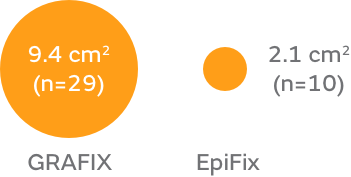GRAFIX◊ Cryopreserved Placental Membrane: Prospective study shows improved closure of chronic venous leg ulcers when added to standard of care11
Study overview
- An investigator-initiated, retrospective, single-center study
- The first and only comparative effectiveness study to report on the clinical outcomes associated with the use of different placental wound care products once broadly implemented in the clinical setting
- All treated wounds inclusive of all durations, sizes, volumes, etiologies and locations that received at least one application of either graft, with one follow-up measurement, were included
- Non-randomized, however statistically equal and homogenous patient cohorts
- Statistical analysis was performed by a blinded third party
Patient demographics and comorbidities and wound characteristics
| GRAFIX | EpiFix | P-Value* | |
|---|---|---|---|
| Patients | 40 | 39 | 0.649 |
| Diabetic | 25.0% | 35.9% | 0.292 |
| Wounds | 46 | 55 | 0.535 |
| Wound (size) | 7.7 cm2 | 7.0 cm2 | 0.769 |
| Wound duration (mean) | 150.9 days | 212.8 days | 0.107 |
Results
Complete wound closure: 63.0% for GRAFIX Membrane versus 18.2% for EpiFix
90% of complete wound closure occurred by week 12

Closure rate with GRAFIX Membrane was significantly higher
Additional considerations
- Final percent area reduction (PAR) of 43.1% for GRAFIX Membrane (n=17) versus -72.6% for EpiFix (n=45)† (p=0.0382)*
- Final percent volume reduction (PVR) of 36.9% for GRAFIX Membrane (n=17) versus -135.7% for EpiFix (n=45)† (p=0.0782)*
Baseline wounds surface area of closed wounds48

Wounds closed with GRAFIX Membrane were 4x larger
p<0.0201
*Based on chi-square test or Fisher’s exact test for categorical variables; t-test with Satterthwaite approximation for continuous variables.
†Based on number of patients with non-closed DFUs within initial 12 weeks.

